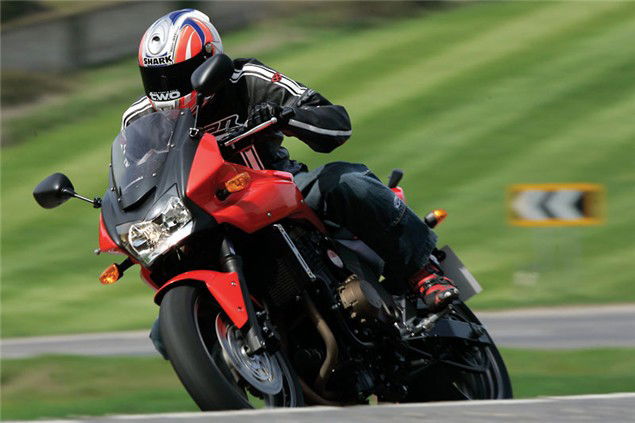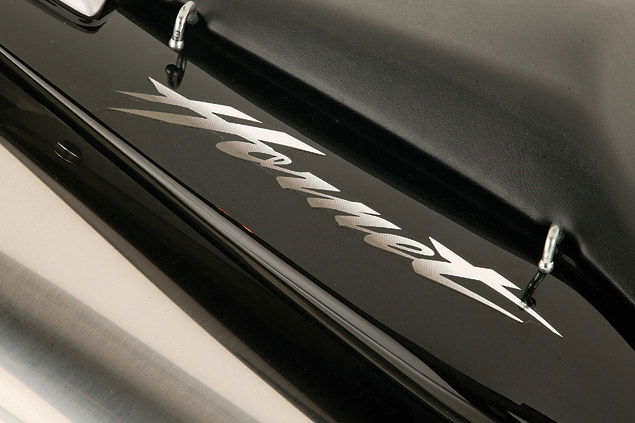Buyer Guide: Kawasaki Z750
The ultimate buyer’s guide to the Z750 written by the people who actually own the bike...


Click to read: Kawasaki Z750 owners reviews, Kawasaki Z750 specs and to see the Kawasaki Z750 image gallery.
No-one knows bikes like the people who buy them and ride them. That’s why in the Buyer Guide we speak to as many owners as possible to get the real life nitty-gritty details about their machines. This questionnaire was all about Kawasaki’s genre-busting middleweight, the brilliant Z750.
The Z750 appeared in late 2003, replacing a rather soggy and sad previous 750 roadster incarnation known as the ZR-7. The sharper, sportier new Z750 moved the budget middleweight class a step forward. Competitors were ageing brochure refugees or 600cc, but Kawaski squeezed a 750 engine in a perky wee chassis and the bike was an instant winner.
Plus it’s got attitude and personality. While a Fazer or Hornet could be accused of being bland, a Z750 is anything but. It’s a practical bike but it’s always up for a laugh too. And with a sensible price tag and advantageous insurance rating it’s seemingly got it all. But what’s it really like to live with? Read on to find out…
Kawasaki Z750 Specs
2003
Engine 748cc, liquid cooled, DOHC, 16-valve, inline four Power 100bhp @ 11,000rpm Top speed 145mph
Torque 55ftlb @ 8,200rpm Dry weight 195kg Seat height 815mm Fuel capacity 18l
2005
Engine 748cc, liquid cooled, DOHC, 16-valve, inline four Power 100bhp @ 11,000rpm Top speed 148mph
Torque 55ftlb @ 8,200rpm Dry weight 199kg Seat height 805mm Fuel capacity 18l
2007
Engine 748cc, liquid cooled, DOHC, 16-valve, inline four Power 105bhp @ 10,500rpm Top speed 150mph
Torque 58ftlb @ 8,300rpm Dry weight 207kg Seat height 815mm Fuel capacity 18.5l

The nuts & bolts
Running costs
Like most Kawasakis, the Z750’s better on fuel than many rivals, especially Hondas. Owners replying to our survey achieved a best average of 60mpg and a worst of 32mpg. A typical figure would be in the high 40s – about 47mpg. Not bad for a comparatively un-aerodynamic machine with decent power. Fuel range
obviously varies according to use too but the average is around 125 miles.
Servicing prices vary from £60 to just under £400. The typical bill is about £170 which is pretty reasonable. Servicing alternates minor / major every 3,500/4,000 miles. The biggy is at 15,000 miles when the valve clearances should be checked – expect to shell about £350 for that. Still, not too bad.
Maintenance – how much do owners do themselves?
None – 44%
Minor jobs like brake pads – 50%
Everything – 6%
Finish
Like all new bikes, the Z750 will corrode if you don’t look after it. The frame and swingarm seem quite prone to rusting. Exhausts are rot prone as is the case with so many Kawasakis. The gold coloured parts on the engine can suffer as well. Otherwise it’s the usual suspects: bolt heads and fasteners, brake disc inners and the heel plates depending on footwear and riding style. Keep the shock and forks clean, too.
Tyres
How long a tyre lasts depends on how the bike’s ridden. Average tyre life is about 5,500 miles rear, 6,500 front but tends to be less from the OE tyres, with the hardest (or maybe heaviest!) riders getting through them in under 2,000 miles.
Continental Road Attacks get the thumbs up from plenty of owners. They grip well, last ages and can generally be bought for a few quid less than the more prestigious brands.
Michelin Pilot Power 2TCs work well as a trackday or summer tyre but Michelin’s more road orientated Pilot Road II are highly rated for all conditions. Bridgestone’s BT-021 and Avon’s Storm ST are also excellent sports touring tyres that cope with all conditions and last well too. If you’re keen to fit sporty rubber Metzeler’s Sportec M3 and the Avon Viper Sport are well thought of and offer more grip than the bike can use. Contis and Michelins are the nod.
Consumables
Most owners are still on the original chain and sprockets which last 15,000-20,000 miles with the right care. Brakes aren’t that strong – they’re just twin piston sliding calipers at the front. Soft compound track pads beef them up a bit, with EBC’s HH being the most popular. the trade off is this increases disc wear but it’s a sacrifice many owners are willing to make. Braided steel hoses are quite popular too.
Owner Case Study: "I’ve modded my engine"
Adam Evans has a 2004 Z750 with 11,500 miles on the clock, 7,500 of which he put on himself. He’s fitted a different flywheel and modified the airbox to give the bike loads more pep. What a lunatic!
"I did both jobs myself. They weren't hard. With the flywheel the hardest part was getting all the bits. It took me about a month looking on eBay to get them. Once I had everything it was a pretty quick job and only took about an hour. The hardest part was getting the old flywheel off. The genuine Kawasaki puller was expensive so I used a jet ski SeaDoo 800/950 one which was £35 rather than £140.
"I used a Pro Engine casing rather than a Kawasaki one as it's stronger – I’d dropped my bike and put a hole in the original casing so I knew they weren’t that durable. It works well. The flywheel's lighter so the engine revs quicker and it feels like it accelerates faster too. I've modified the airbox as well. It's a well known trick. You cut away most of the top half so there’s just the plastic that keeps the filter in place. I've got a Power Commander which helps the bike make the most of this mod but it shouldn’t always be necessary as the fuel injection seems to have plenty of its own adjustment and would compensate for it anyway."

Bodywork
There’s a bewildering range of plastics and bodywork available for a Z750. Screens can help reduce wind blast but some people find they make little difference. It depends on how tall the rider is and what helmet they wear. Ermax screens seem to be the most popular. Under trays and brackets to eliminate the number plate hanger are popular and give the bike a really sporty, mean look. Beware cheap tat though, Ermax and Powerbronze get good reviews from our readers. Avoid the rest.
The rear plastics of the ’03-’06 model are identical to the ZX-6R B1H and B2H (2003 and 2004 models) which can be useful if you’re looking for parts in breakers.
Suspension
Touted as a Z750 weak point. To be fair, for a cost-conscious bike it’s fine but considering this is a machine that punches so high above its price tag / market niche it is worth upgrading.
The OE shock’s a cheapie. Make sure the rebound damping is set to maximum (position 4). Some owners fit the unit from a ZX-9R E-series which has greater adjustability but needs the hugger trimming to squeeze it into place. The cheapest replacement is Hagon at £255 and is an adjustable, rebuildable unit. Nitron also offer decent shocks for sensible money. If you’re determined to have the best, Öhlins and some other big names do a fitment. But that’s overkill.
The standard forks are fairly basic. Hyperpro springs (and fresh oil) make a big difference and its something a competent home mechanic can DIY for less than £100. If you’re feeling saucy the whole front end including upside down forks from the 2003/04 636cc ZX-6R will fit if you use yokes from a Z1000.
D.I.Y Tuning
Lots of owners modify the airbox and reckon it gives the bike a boost in torque and power. You can either cut away most of the top half of the airbox yourself or, better still, buy a professionally made version. Micron sell them but you have to go via their German website or try www.carpimoto.it.
Another popular mod is fitting the flywheel from a ZX-9R. It makes the engine rev faster. You don’t just need the flywheel, you also need the gear clutch (the sprocket at the back of the flywheel), starter, idler gear and crankcase cover too – all from a ZX-9R E or F-series bike (that’s the 2000 onwards versions).
What goes wrong
Very little. Many machines are still under the factory warranty (24 months / unlimited miles). Some owners report the odd loosening nut. It’s worth giving a bike a visual once-over every few months or better still with some spanners or sockets just to make sure nothing’s coming free. The sidestand bolts seem particularly prone to slackening themselves off as does the gear linkage. Which could be rather irksome.
The engine cases are pretty thin so a minor drop or low speed accident can hole them meaning it’s AA truck home time. Worth changing to Factory Pro if you can face the cost.
The mirrors vibrate but that’s more an annoyance than a problem, ditto clocks that are hard to read in bright sunshine.
Owner Case Study: "11,000 miles in one year!"
Ian Jennings commutes all year on his Z750 – and rode it to France and back in February 2007. He rates the Z750 over competitors on everything except comfort. Yeah, if there is one common complaint among Z750 owners, it’s that damn seat.
“I use it for leisure riding as well as my 20 mile daily commute. I’ve clocked up about 11,000 miles in just over a year. The bike’s been great. I find the front forks a bit soft. Also the seat isn’t that comfy – when I rode to Paris I had to walk around at every fuel stop to get the feeling back. Otherwise it was fine on that trip. I used Oxford soft panniers which were easy to secure thanks to the decent luggage hooks.?I had a Bandit 600 before and the Z750’s better in every way except for comfort.
"I’d like a big naked bike next like an Aprilia Tuono or a KTM Superduke. I use the bike all through winter and the finish has stood up pretty well. There’s a couple of rough spots on the top of the fork legs behind the cowling where it’s difficult to clean but they’ll polish out. And the rear brake light switch can stick on as it gets lots of road crud thrown at it but it’s easy to free off and give it a drop of oil so it keeps working. You have to really look after it over winter or the paint and coatings can certainly suffer.”





